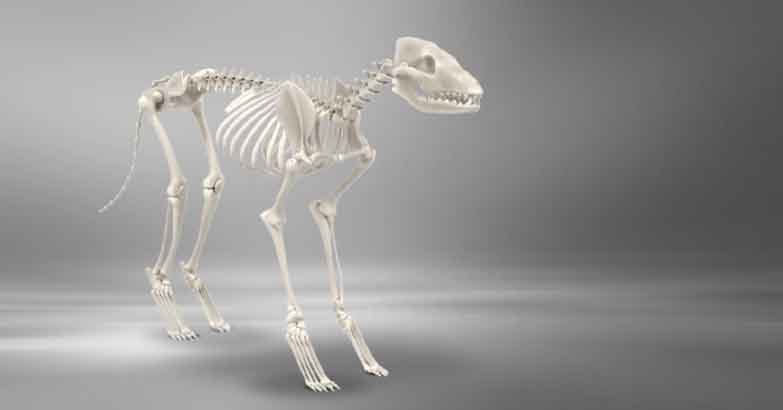It’s estimated that 25% of dogs today will develop osteoarthritis at some point in their lives. And while it was common in older dogs, now this degenerative condition is seen in dogs of all ages, and large and small breeds.
But dogs with signs of osteoarthritis don’t need to live a lifetime of pain and discomfort. There are lifestyle changes and natural treatments that can minimize inflammation and degeneration.
Here’s what you need to know …
What Is Osteoarthritis In Dogs?
Osteoarthritis in dogs is a chronic degenerative joint disease that affects the cartilage and underlying bone in a dog’s joints. It causes pain, stiffness, and reduced mobility. It’s the most common form of arthritis.
Joints have a protective cartilage to cushion them and produce a lubricating fluid. This is like a shock absorber that helps the joint move without any friction or pain. But through injury or inflammation, the cartilage begins to wear away, causing the bones to rub against each other. This leads to chronic inflammation and pain in the affected joint. Over time, the joint may become less flexible, and the surrounding muscles may weaken, leading to further loss of mobility.
RELATED: How to manage chronic inflammation in dogs …
Causes of Osteoarthritis In Dogs
There are a lot of factors that contribute to osteoarthritis in dogs.
Inflammation
Inflammation is the immune system’s response to injury. When there isn’t sufficient treatment or proper rest and recovery for a dog with injured or aging joints, ongoing inflammation can cause further damage to the joint tissues … and that leads to chronic inflammation and potentially, osteoarthritis.
Obesity
Excess weight puts additional strain on a dog’s joints, which can increase the risk of developing osteoarthritis.
Aging
As dogs age, their joints (including the cartilage that protects and cushions them) may begin to show signs of wear and tear, leading to the development of osteoarthritis.
Genetics
Certain dog breeds are more predisposed to developing osteoarthritis due to their genetics. For example, large breed dogs such as Labrador Retrievers, Rottweilers and German Shepherds are at higher risk.
Joint Injuries
Previous joint injuries, such as a torn ligament or fracture, can increase the risk of developing osteoarthritis in the affected joint. Overactive or adventurous dogs may also develop overuse injuries.
Abnormal Joint Development
Dogs with abnormal joint growth, such as hip dysplasia and irregular growth plate development, are at increased osteoarthritis risk.
Underlying Conditions
Dogs with other conditions, such as autoimmune disorders, may be more susceptible to osteoarthritis.
Signs Of Osteoarthritis In Dogs
Signs of osteoarthritis in dogs will be noticeable. including:
- Stiffness, especially in the morning or after rest.
- Limping or favoring one limb over the other.
- Difficulty rising or reluctance to get up.
- Less active – less willing to play, go for walks, or other activities.
- Reduced range of motion in the affected joint when they walk, run or jump.
- Swelling or heat in the affected joint.
- Difficulty going upstairs or jumping in the car.
- Pain shown by whining or whimpering when touched in the affected area.
4 Stages Of Osteoarthritis In Dogs
Osteoarthritis in dogs is a progressive disease that usually develops in 4 stages:
Stage 1 – Mild osteoarthritis: Minor changes in the joint, such as thinning of the cartilage, but you may not see no obvious signs.
Stage 2 – Moderate osteoarthritis: More pronounced cartilage damage, with signs of pain, stiffness, and reluctance to move.
Stage 3 – Severe osteoarthritis: Significant cartilage loss, and the dog may experience chronic pain, limited mobility, and muscle atrophy. Your dog may also develop bony growths, called osteophytes, around the affected joint.
Stage 4 – End-stage osteoarthritis: The joint is severely damaged, and your dog may have a complete loss of mobility. Your dog may also experience significant pain, which may be difficult to manage. If your dog’s nearing the end of his life and needs extra pain management, this is one time when you shouldn’t be afraid to use pharmaceuticals if they help provide relief.
The progression of osteoarthritis varies depending on the dog’s age, breed, overall health, and other factors.
RELATED: Natural joint supplements for dogs …
Natural Remedies For Osteoarthritis In Dogs
Here are some natural remedies to help manage osteoarthritis symptoms in dogs.
- Omega-3 fatty acids have anti-inflammatory properties that can help reduce joint inflammation and pain. Add a supplement like green lipped mussel oil, or feed fatty fish like salmon. mackerel or sardines.
- Astaxanthin is a powerful antioxidant and a natural joint supplement that can relieve pain and inflammation.
- Glucosamine and chondroitin are compounds that help support joint health and may help slow the progression of osteoarthritis. Beef trachea or chicken feet or necks and bone broth are good food sources of these substances. You can also buy glucosamine and chondroitin supplements.
- Turmeric contains curcumin, which has anti-inflammatory properties that can help reduce joint pain and inflammation. You can add fresh turmeric root to your dog’s food or give a supplement with turmeric or curcumin.
- Homeopathic remedies are helpful in managing osteoarthritis in dogs. it’s best to consult a veterinary homeopath who can prescribe the best remedy for your dog based on his overall symptoms.
RELATED: Herbs for arthritis in dogs …
CBD For Osteoarthritis In Dogs
CBD oil has anti-inflammatory and pain-relieving properties for dogs with osteoarthritis. CBD can be used orally and topically …
- Oral CBD: Give a CBD tincture directly in the mouth, or with food or treats. Caution with CBD treats which aren’t usually as effective. CBD oil is available in different strengths, and the amount needed varies by individual. Start with the manufacturer’s dosing guidelines, but you may need to increase dosage until you see it’s effective. Or if it makes your dog sleepy, you might want to reduce the dose a little.
- Topical CBD: You can apply CBD balms or creams directly to the affected joint. This can provide targeted pain relief and reduce inflammation.
RELATED: Benefits of CBD oil for dogs …
Management Of Osteoarthritis In Dogs
In addition to the earlier suggestions, there are a few other ways to manage osteoarthritis in dogs:
- Feed a fresh, whole food diet, avoiding starchy carbohydrates that lead to inflammation.
- Control your dog’s weight with diet and regular exercise to avoid extra stress on his joints. Regular exercise will help maintain his mobility.
- Physical therapy at a veterinary rehabilitation facility can help keep your dog moving. Hydrotherapy like swimming or underwater treadmill, as well as stretching and strengthening exercises, can be very effective.
- Gentle massage and stretching can help improve your dog’s joint flexibility and reduce stiffness. You can work with a canine massage therapist or learn how to do massage and stretching techniques yourself.
- Modify your dog’s environment to reduce the stress on his joints and improve quality of life:
- Provide a supportive bed (memory foam is a good option)
- Use a ramp, steps or a harness to help with stairs or getting in the car
- Put down non-slip mats or rugs (yoga mats work well) on hardwood or tile floors
- Use non-slip dog socks or toenail grips to help your dog on slippery surfaces
- Provide your dog with a comfortable, low-stress environment so he can feel more relaxed and reduce stress on his joints.
- Use a heating pad or warm towel to soothe his joints.
- Provide recreational bones, toys or puzzles to keep him mentally stimulated.
- Giive him plenty of personal attention too. It’s easy to ignore a dog who sleeps most of the day but he’ll benefit from some extra love and kindness.
Osteoarthritis In Dogs Life Expectancy
Usually, the life expectancy of dogs with osteoarthritis is not directly affected by the condition. However, reduced quality of life can be a factor, especially in severe cases. Chronic pain, stiffness, and limited mobility can make it difficult for arthritic dogs to take part in physical activities, and can affect their overall enjoyment of life.
But. as soon as you notice your dog developing mobility issues from osteoarthritis, there are plenty of steps you can take to slow its progression and prolong your dog’s quality of life.
References
Gamble L et al. Pharmacokinetics, safety, and clinical efficacy of cannabidiol treatment in osteoarthritic dogs. Frontiers in Veterinary Science. 2018.
Daily J, Yang M, Park S. Efficacy of Turmeric Extracts and Curcumin for Alleviating the Symptoms of Joint Arthritis: A Systematic Review and Meta-Analysis of Randomized Clinical Trials. Journal of Medicinal Food. 1, August 2016.
Hielm-Björkman et al. Evaluating Complementary Therapies for Canine Osteoarthritis Part I: Green-lipped Mussel (Perna canaliculus). Evid Based Complement Alternat Med. 2009;6(3):365-373.












